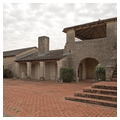The familiar 1930s “rustic” buildings and landscapes in national, state, and local parks emerged from the bittersweet years of the Great Depression. With Franklin D. Roosevelt's inauguration as president in March 1933, promotion of conservation and public recreation grew to the level of national crusades.
The president's New Deal cabinet created the Civilian Conservation Corps CCC quickly and enthusiastically, placing some 275,000 volunteer enrollees in camps by June 1933. The CCC provided jobs and family income for America's young men and war veterans, groups hit hard by the Depression, while enrollees performed beneficial conservation tasks on equally hard-hit lands. Through local cooperation with federal agencies, Texas welcomed the CCC as a vehicle for preserving natural resources and developing park lands.
Barely three months after its creation, the CCC occupied 1,520 camps throughout the United States, with 34 companies assigned to Texas for various tasks, including 16 CCC companies rapidly building the state's new recreation park system. Professional architects, landscape architects, and engineers found employment as designers and supervisors of construction in parks. Each camp also hired “locally experienced men” LEMs as skilled artisans and instructors.
The first four CCC state-park companies in Texas established camps in 1933 at Caddo Lake, Blanco, Davis Mountains, and Mineral Wells. Eventually the State Parks Board a predecessor of today's Parks and Wildlife Department selected sites with National Park Service NPS advice and together these partners developed master plans for park developments with CCC labor. Spectacular facilities emerged, but throughout its duration the program remained strongly influenced by politics, particularly through the powerful New Deal patrimony of Texas congress men, U.S. senators, and John Nance Garner of Uvalde, Roosevelt's crusty vice president for eight years.
The NPS, headed by veteran national park designer Herbert Maier, generously and zealously brought its high standards and development skills to state and local park programs. With an attitude that each building and structure was an intrusion in the natural landscape, NPS designers had determined in the 1920s that park facilities should be small in scale and relate closely to their sites. Therefore, they should be built of native materials and finished with simple tools.
Low silhouettes and horizontal coursings gave each building a harmonious relationship with the ground. Heavy stone foundations and roughly hewn timber frames—where such materials were available—tied these designs to early “pioneer” efforts, perceived by the NPS as ideally sensitive to the natural surroundings. The NPS reluctantly labeled its style as “rustic,” but in recent years admirers have fastened the term “NPS Rustic” to a majority of park facilities built between 1916 and 1942.
Execution of NPS Rustic principles proved remarkably consistent. At the commencement of each project, federal architects traveled to the park site and instructed local designers on proper recreation facility design and construction. The on-site NPS-paid architect, landscape architect, and engineer then submitted proposals to senior designers for approval of each building and structure in the master plan. The local park architects, with Beaux-Arts training and experience far outside the specialized field of park design, invariably worked a few of their own ideas and whims into these buildings.
Many of the Texas recreation parks of this period featured a central “refectory” building see PV2. Combining a group shelter with toilets, kitchen, patio, and—always—huge rustic fireplaces, the refectory stood as the most visible building in the park. Other park buildings in rocky or forested settings were cleverly designed and built to appear as if they had grown out of the ground.
Landscape improvements invariably emerged as part of the encompassing park master plan, and the CCC work schedule. Structures including dams, culverts, bridges, and fences followed the same nonintrusive principles as park buildings. Workers cleared scenic drives carefully and laboriously through picturesque areas to allow access—and exhilarating glides through nature—for motorists at practically every park.
Many Texas parks still prominently display the rustic and historic themes of their CCC heritage. The “army in overalls” built durable facilities that continue to function well under tremendous user demands. The park building boom of 1933–1942 is distinctive in Texas because of the federal government's influential role in establishing and maintaining NPS Rustic as its signature style throughout the New Deal. An evident hand-worked appearance of each building, structure, and landscape feature unmistakably identifies the effort with an era of liberal time and labor allotments. CCC and NPS participants were happy to have the work, and they were proud of their accomplishments.
Writing Credits
If SAH Archipedia has been useful to you, please consider supporting it.
SAH Archipedia tells the story of the United States through its buildings, landscapes, and cities. This freely available resource empowers the public with authoritative knowledge that deepens their understanding and appreciation of the built environment. But the Society of Architectural Historians, which created SAH Archipedia with University of Virginia Press, needs your support to maintain the high-caliber research, writing, photography, cartography, editing, design, and programming that make SAH Archipedia a trusted online resource available to all who value the history of place, heritage tourism, and learning.


